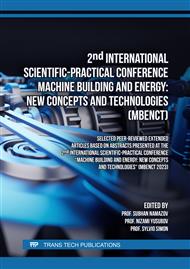[1]
I. A. Ibrahim, H. TH. Salim, H. F. Khazaal. Investigating the Analysis of Power Saving Mode in IEEE 802.11 for Wi-Fi Communication. Wasit Journal of Engineering Sciences. 6, 3 (2018) 13–19.
DOI: 10.31185/ejuow.vol6.iss3.100
Google Scholar
[2]
B. G. Ibrahimov, Y.S. Isayev, M.E. Aydemir. Performance of MultiService Telecommunication Systems Using the Architectural Concept of Future Networks. Journal of Aeronautics and Space Technologies. Vol. 16, No.1, 2023. pp.41-49
Google Scholar
[3]
V. Bhargava, N. Raghava. An Enhancement for IEEE 802.11 STA Power Saving and Access Point Memory Management Mechanism Electronics. 11, 23 (2022).
DOI: 10.3390/electronics11233914
Google Scholar
[4]
M. Nurchis, B. Bellalta. Target Wake Time: Scheduled Access in IEEE 802.11ax WLANs. IEEE Wireless Communications, 2019, vol. 26, no. 2, p.142–150.
DOI: 10.1109/mwc.2019.1800163
Google Scholar
[5]
A. A. Benbuk, N. Kouzayha, F.A. Asadallah, J. Costantine, and Z. Dawy. Ultra-Low Power Pulse width Detector for RFWake-Up Receivers. 2019 IEEE International Symposium on Antennas and Propagation and USNC-URSI Radio Science Meeting. Atlanta: IEEE, 2019. p.1461–1462.
DOI: 10.1109/apusncursinrsm.2019.8889291
Google Scholar
[6]
E. Khorov, A. Kiryanov, A. Lyakhov, and G. Bianchi. A Tutorial on IEEE 802.11ax High Efficiency WLANs. IEEE Communications Surveys and Tutorials. 21, (2018) 197–216.
DOI: 10.1109/comst.2018.2871099
Google Scholar
[7]
A. Rustamov, K. Gurbanov, V. Katexliyev. Calculation of the destruction effectiveness of military ships' fire means according to the impact distance. National Security and Military Sciences, 3(9), 2023, pp.44-50.
Google Scholar
[8]
Juan Pablo, Garcia Baquerizo, Alvaro Suarez, Elsa Macias and Edgar Salas.Hardware Mechanism for Energy Saving in Wi-Fi Access Points. Sensors, 19, 4745 (2019).
DOI: 10.3390/s19214745
Google Scholar
[9]
A. Rustamov, M. Binnetov, K. Gurbanov. Ensuring reliability in upgrading and maintaining special-purpose radioelectronic equipment. Vasil levski national military university security and defense scientific journal year, II Issue 2, 2023. pp.1-7.
Google Scholar
[10]
V.A. Tikhvinsky, S.V. Terentyev, V.A. Koval, E.E. Devyatkin. Development mobile communication networks from 5G Advanced to 6G: projects, technologies, architecture. E-Publishing Inc., Moskow, Technosphere, (2023). pp.22-87.
Google Scholar
[11]
E Ferro, F. Potorti. Bluetooth and wi-fi wireless protocols: A survey and a comparison. IEEE Wirel. Communication. 12, (2005) 12–26.
DOI: 10.1109/mwc.2005.1404569
Google Scholar



